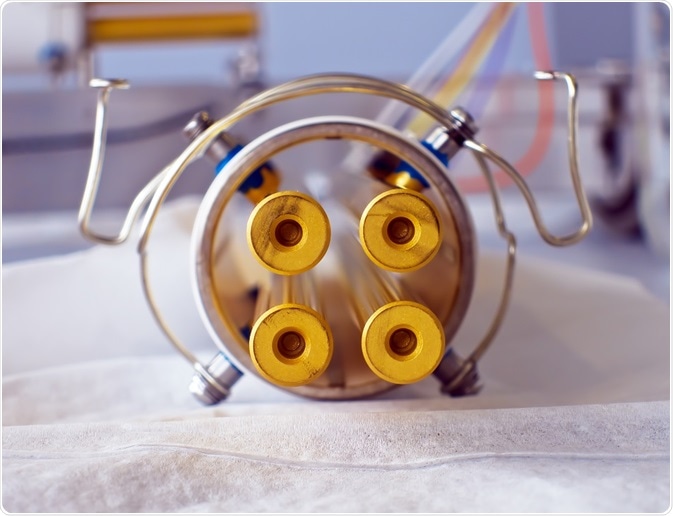By Jeyashree Sundaram, MBA
A miniature mass spectrometer (MS)/mass analyzer is a device used to measure the mass/charge ratio of ionized atoms or other electrified substances.

Credit: Jens Goepfert/ Shutterstock.com
The process of isolation of ions corresponding to their mass-to-charge ratio differs based on the working principles of every distinct mass analyzer.
Mass analyzers are used in various fields such as biology, physics, geology, chemistry, and medicine to determine compositions, measure isotopic ratios, detect leaks in vacuum systems, and in homeland security. The categorization of mass analyzers is carried out based on their resolution, mass accuracy, mass range, MS/MS acquisition, and precision.
Magnetic deflection analyzers
In a magnetic deflection mass analyzer, ions leaving the source are accelerated to a high velocity and a strong magnetic field is applied in the perpendicular axis to the direction of the motion of ion. This is done in a magnetic sector inside the analyzer.
Due to this phenomenon, the path motion of the ion is subjected to continuous angular deviation, thus forming a semi-circular path. The magnetic sector also follows a path that resembles the shape of an arc. The radius and angle of the arc varies with different ion optical designs.
A magnetic sector is capable of isolating the ions from their sources that correspond to their mass to ratio, but the resolution obtained is inadequate. This is due to the variation in the energy and velocity of the isolated ions. In order to improve the resolution, an electric sector is combined along with the magnetic sector that directs the isolated ions according to their kinetic energy.
Magnetic deflection analyzers are used as a major application in all organic mass spectrometric analyzing techniques, to obtain accurate mass measurements in the quantitation process, and in isotope ratio measurements.
Quadrupole mass analyzer
Quadrupole mass analyzers are most often used in clinical labs. The assembly of this system consists of four parallel equidistant metal rods with two opposite pairs that are electrically coupled. A DC voltage of equal and opposite magnitude overlapped by a radio frequency AC voltage is applied on the diagonal pair of metal rods.
This results in the formation of an electric field that forces the ion to travel in the z-direction with an oscillatory motion in the x-y plane. The oscillation amplitude reveals the relation with the mass-to-charge ratio and can be controlled by simultaneous alteration of the DC and RF AC voltages.
Quadrupole mass analyzers are cost-effective, smaller in size, efficient, and can be easily coupled with various inlet systems.
It is involved as an application in the process of gas chromatography and liquid chromatography. It is also applied in hybrid systems that include both magnetic deflection and quadrupole systems.
Tandem quadrupole system
Tandem quadrupole system consists of three linear quadrupoles, and it is also known as triple-quad. The precursor ion (or the analyte ion) is selected according to their mass-to-charge ratio by the first quadrupole.
Then it is left to collide with a collision gas (such as argon) in the second quadrupole collision cell. As soon as the collision occurs, it stimulates the fragmentation of the precursor ions and this phenomenon is known as collision-induced dissociation (CID).
The resulting ions after CID are associated with the molecular structure and they are supervised by the third quadrupole analyzer. This type of purification system avoids complex practices that need to be performed prior to mass spectrometric analysis.
Ion trap mass analyzer
Ion-trap mass analyzers (IT/MS) are recently developed systems that possess several beneficial features that include small size, economic price, and ability to perform tandem CID monitoring. The system consists of three electrodes—the entrance, ring, and cap electrode.
A cavity is developed by these electrodes, which is used to trap and examine the ions. The two end cap electrodes contain a hole at their center to provide a provision for the moving ions. The ring electrode is positioned at the center between the end cap electrodes.
The ions isolated from their source are passed into the trap by the quadrupole and the entrance end cap electrode. The voltages of the electrodes are varied according to the mass-to-charge ratio of each ion in order to trap and eject them from their sources.
An AC voltage with constant frequency and variable amplitude is applied to the ring electrode to generate a 3D quadrupolar potential field inside the trapping cavity. This results in stable trapping of ions in an oscillating path limited within the cell.
The characteristics of the path depend on the trapping voltage and the mass-to-charge ratio of the ion. The electrode voltages are modified to generate variations in the ion pathways and to eject ions in the axial directions.
Time-of-flight mass analyzer
Time of flight (TOF/MS) analyzers are devices with advantageous features like wide mass range high scanning speed, resolution of up to 40,000, very high ion collection efficiency, and high dynamic range. TOF is apt for studying complex metabolomics specimens. It is used for rapid scanning of the whole spectrum and obtaining qualitative information.
Further Reading